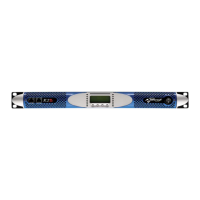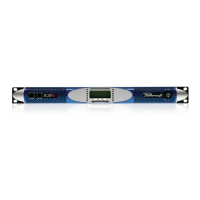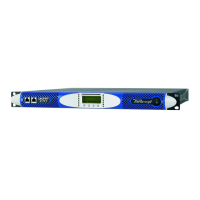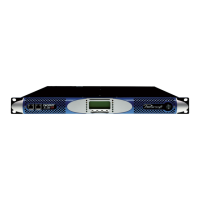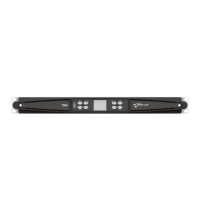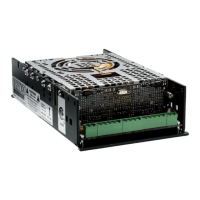Port 1
(master)
Port 2
(master)
Port 3
(slave)
Port 4
(slave)
Port 1
(master)
Port 2
(master)
Port 3
(slave)
Port 4
(slave)
Port 1
(master)
Port 2
(master)
Port 3
(slave)
Port 4
(slave)
Port 1
(master)
Port 2
(master)
Port 3
(slave)
Port 4
(slave)
Ethernet network
Device mode: forward to AES3-A
Device mode: repeat
Device mode: repeat
Device mode: forward to AES3-A
AES3 source
AES3-A
Ethernet
FIGURE 59: Intermediate connection, internally robust with respect to
the AES3 stream. Four-port-amplier diagram
Ethernet network
AES3 source
Port 1
(master)
Port 2
(master)
Device mode: forward to AES3-A
Port 1
(master)
Port 2
(master)
Device mode: repeat
Port 1
(master)
Port 2
(master)
Device mode: repeat
Port 1
(master)
Port 2
(master)
Device mode: forward to AES3-A
AES3-A
Ethernet
FIGURE 60: Intermediate connection, internally robust with respect to
the AES3 stream. Two-port-amplier diagram
10 KAESOP Network settings menu
In all the menus illustrating a series of possible alternatives that a
specic amplier parameter can have, a diamond shape will mark
the value set for that specic parameter.
Many of the menus in this section require the user to select
one functioning mode from a set of possible alternatives. These
alternatives are all presented in a list. A black diamond shape
next to a specic item in the list indicates that that is the selected
option.
In FIGURE 61, for example, the selected device mode is “Forward
to AES3-A” because the diamond shape appears next to it in the
Device mode list.
Repeat (default)
back
sel
Forward to AES3-A
Forward to AES3-B
FIGURE 61: The black diamond next to the “Forward to AES3-A” item
indicates that it is the currently set device mode
10.1 Device Mode
This parameter sets the amplier mode with respect to the AES3
stream
▶
Repeater: the AES3 stream received on port 1 is repeated to
port 2 and vice versa
▶
Forward to AES3-A: the AES stream from the rear panel XLR
is rerouted to exit both RJ45 master ports as an AES3-A
stream. The amplier will be in repeater mode with respect
to the AES3-B stream
▶
Forward to AES3-B: the AES stream from the rear panel
XLR is rerouted to exit both RJ45 master ports as an AES3-B
stream. The amplier will be in repeater mode with respect
to the AES3-A stream
▶
Forward to both: the AES stream from the rear panel XLR
is rerouted to both AES3-A and AES3-B streams out both
RJ45 master ports. The repeater mode is disabled in this
conguration.
Note: when an amplier is in forward mode (either to AES3-A,
AES3-B or both) the amplier can only accept the AES signal
coming from the rear panel XLR connector. AES3 streams
incoming from any other RJ45 port are ignored.
10.2 Addressing Mode
This parameter controls the IP addressing assignment strategy:
▶
“Manual” requires the user to set a valid static address and
subnet mask (and, optionally, the default gateway). The PC
should be on the same subnet of the amplier if no routers
are present between the PC and amplier.
▶
“Automatic” lets the amplier ask and obtain a network
conguration from a DHCP server. Starting from power-on,
the amplier tries to obtain a valid IP address from a DHCP
server. After a timeout of 30 seconds, if an IP address is not
obtained, the amplier takes an automatic private address in
the range 169.254.x.y, but continues to search for a DHCP
server. When the DHCP becomes available, the address is
updated. If no DHCP server is available, the amplier obtains
an IP address by Automatic IP (local link addressing or

